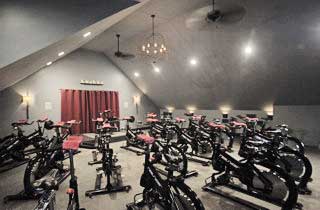Lisa Wisentaner, a seasoned RealRyder® Certified Instructor and Owner of Nantucket Cycling Studio in Massachusetts, is all too familiar with helping first-timers acclimate to the RealRyder Bike. Travelers swarm to the island every summer, and head to Lisa’s studio to get their fitness fix. Acclimating first-timers to any fitness modality takes time, empathy and patience on an instructor’s part. Lisa sees this not as a challenge, but a huge opportunity to make a difference in someone’s life. We recently caught up with Lisa to see what new learnings she could share with our instructor- community when it comes to transitioning clients to their very first ‘un-stationary’ indoor cycling class. Read on!
RRI: “What’s the average percentage of first-time riders in your classes during the summer months?”
LW: “We have anywhere from 25% to 75% of new riders in our classes during the high season.”
RRI: “We know you ask new riders to arrive 15 minutes prior to the start of class, but we also know not everyone does that! What are some ways you can quickly ensure all newbies are set up for success before it’s time to start the ride?”
LW: “The first thing we do is make sure every rider new to our studio is set up correctly. We always ask if they have indoor cycling experience and the most common response we get it ‘yes, just not on the bikes that move.’ So, we reinforce to them that it’s just a bike and the fact that the bike moves is no big deal. ‘Don’t over-think it’…is a big piece of advice! Riders new to RealRyder bikes have a tendency to want to control or manhandle the bike. We explain a key difference in stationary cycling versus a RealRyder Class is that the RealRyder Bike gives them feedback on their form. We emphasize and continually cue the importance and value of proper technique and pedal stroke. Once they understand that the key to controlling the bike is all about them, they refocus their energy to their body and not the bike. Then our top priority is to make people feel comfortable by letting them know that we are a judgment-free zone. We encourage them to modify and take control of their own workout. If it feels better in their body to do something different than we are offering, we encourage them to take control.
RRI: “As class ensues, inevitably, you must look out and see some new riders out of proper riding alignment, lacking core or hip flexor strength and as a result, they’re swaying awkwardly. How do you address that?”
LW: “We use a variety of physical cues combined with encouragement. I reinforce them to listen, but also to ‘watch’ me and others, and they’ll get it. My goal is not to make beginners look perfect. I always say to riders who are new to our studio “If what I’m asking you to do makes sense, participate, if it doesn’t, keep pedaling and observe.” I really think it’s easy to over-think explaining the bike, how to get the proper rhythm down… I’m really just trying to help people fall into the rhythm as they feel ready. After one or two classes, the clients forget they were ever on a bike that didn’t move.”
RRI: “We know a lot of New Yorkers, who are regulars at popular boutique cycling studios, jump into your classes in the summer while they’re vacationing. How do these folks adjust to what you’re offering?”
LW: “I love when people come in with the attitude that we won’t measure up to what they are used to. It used to be intimidating but now, we see this as an opportunity. The bottom line is, these bikes don’t allow us to do anything but focus on proper pedal stroke and good technique. There is a lot of pressure in indoor cycling these days to entertain our clients. We would prefer to be remembered for providing them with an unforgettable experience based on dynamic coaching, great profile design, great music and good ol’ fashioned hard work. We also like to remind people that their arms are not getting them any farther or faster. If your bike is overly moving, then listen to that feedback and clean up your form. I empower people to think like an athlete and identify a bigger goal than just sweat. All of the hours they cycle each week should lead to something…a greater purpose.”
RRI: “You’ve clearly learned a lot with your seasonal influx of new riders over the past 5 years. Do you have any tips for new RealRyder Instructors or Program Owners?”
LW: “It really makes you a better instructor, the more you work with new riders. As an owner, it can be challenging. You want people to have fun, to get a great workout, to come back, but you don’t have to compromise safe and effective coaching to engage clients. The focus should be about high quality instruction and awesome ride profiles. It takes a lot of physical and emotional energy, but I want every class to be the best class ever. The reality is that our clients are still in the same spot at the beginning and at the end of their class. Their experience on that journey to nowhere is all about what we bring to the table.”


